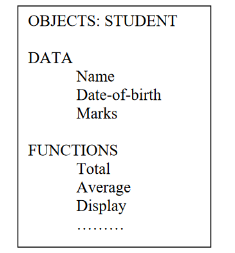|
|
Procedure oriented programming basically consists of writing a list of instructions for the computer to follow, and organizing these instructions into groups known as functions. We normally use flowcharts to organize these actions and represent the flow of control from one action to another.In a multi-function program, many important data items are placed as global so that they may be accessed by all the functions. Each function may have its own local data. Global data are more vulnerable to an inadvertent change by a function. In a large program it is very difficult to identify what data is used by which function. In case we need to revise an external data structure, we also need to revise all functions that access the data. This provides an opportunity for bugs to creep in.Another serious drawback with the procedural approach is that we do not model real world problems very well. This is because functions are action-oriented and do not really corresponding to the element of the problem.Some Characteristics exhibited by procedure-oriented programming are: • Emphasis is on doing things (algorithms). • Large programs are divided into smaller programs known as functions. • Most of the functions share global data. • Data move openly around the system from function to function. • Functions transform data from one form to another. • Employs top-down approach in program design.3. Write the Principles of Object-Oriented SystemsThe conceptual framework of object–oriented systems is based upon the object model. There are two categories of elements in an object-oriented system −Major Elements − By major, it is meant that if a model does not have any one of these elements, it ceases to be object oriented. The four major elements are −
1 2 3 4 5 6 7 8 9 10 11 12 13 | class HumanBeing{ public: HumanBeing(std::stringn):name(n){} virtual std::string getName() const{ return name; } private: std::string name; };
class Man: public HumanBeing{};
class Woman: public HumanBeing{}; |
1 2 3 4 5 6 7 8 9 10 11 12 | template <typename T> void xchg(T& x, T& y){ T t= x; x= y; y= t; }; int i= 10; int j= 20; Man huber; Man maier;
xchg(i,j); xchg(huber,maier); |
1 2 3 4 5 6 7 8 9 10 11 12 13 14 15 | template <typename T, int N> class Array{ public: int getSize() const{ return N; } private: T elem[N]; };
Array<double,10> doubleArray; std::cout << doubleArray.getSize() << std::endl;
Array<Man,5> manArray; std::cout << manArray.getSize() << std::endl; |
1 2 3 4 5 6 7 8 9 10 11 12 13 14 15 16 | std::vector<int> vec{1,2,3,4,5,6,7,8,9}; std::vector<std::string> str{"Programming","in","a","functional","style."};
std::transform(vec.begin(),vec.end(),vec.begin(), [](int i){ return i*i; }); // {1,4,9,16,25,36,49,64,81}
auto it= std::remove_if(vec.begin(),vec.end(), [](int i){ return ((i < 3) or (i > 8)) }); // {3,4,5,6,7,8} auto it2= std::remove_if(str.begin(),str.end(), [](string s){ return (std::lower(s[0])); }); // "Programming"
std::accumulate(vec.begin(),vec.end(),[](int a,int b){return a*b;}); // 362880 std::accumulate(str.begin(),str.end(), [](std::string a,std::string b){return a + ":"+ b;}); // "Programming:in:a:functional:style." |
 Classes We just mentioned that objects contain data, and code to manipulate that data. The entire set of data and code of an object can be made a user-defined data type with the help of class. In fact, objects are variables of the type class. Once a class has been defined, we can create any number of objects belonging to that class. Each object is associated with the data of type class with which they are created. A class is thus a collection of objects similar types. For examples, Mango, Apple and orange members of class fruit. Classes are user-defined that types and behave like the built-in types of a programming language. The syntax used to create an object is not different then the syntax used to create an integer object in C. If fruit has been defines as a class, then the statement Fruit Mango; Will create an object mango belonging to the class fruit.9. Explain Data Members"Data Member" and "Member Functions" are the new names/terms for the members of a class, which are introduced in C++ programming language.The variables which are declared in any class by using any fundamental data types (like int, char, float etc) or derived data type (like class, structure, pointer etc.) are known as Data Members. And the functions which are declared either in private section of public section are known as Member functions.There are two types of data members/member functions in C++:
Classes We just mentioned that objects contain data, and code to manipulate that data. The entire set of data and code of an object can be made a user-defined data type with the help of class. In fact, objects are variables of the type class. Once a class has been defined, we can create any number of objects belonging to that class. Each object is associated with the data of type class with which they are created. A class is thus a collection of objects similar types. For examples, Mango, Apple and orange members of class fruit. Classes are user-defined that types and behave like the built-in types of a programming language. The syntax used to create an object is not different then the syntax used to create an integer object in C. If fruit has been defines as a class, then the statement Fruit Mango; Will create an object mango belonging to the class fruit.9. Explain Data Members"Data Member" and "Member Functions" are the new names/terms for the members of a class, which are introduced in C++ programming language.The variables which are declared in any class by using any fundamental data types (like int, char, float etc) or derived data type (like class, structure, pointer etc.) are known as Data Members. And the functions which are declared either in private section of public section are known as Member functions.There are two types of data members/member functions in C++:
